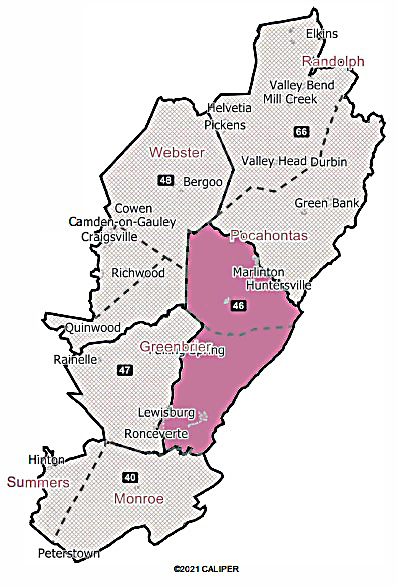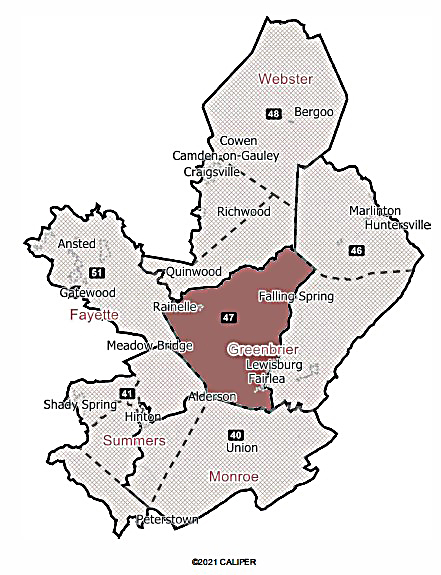
By Adam Pack
With the release of the results of the 2020 census, the West Virginia Legislature met to redistrict the state to reflect the most recent data. Members from both the West Virginia House and Senate convened in a special session in Charleston between Oct. 11 and Oct. 20, as per a declaration from Governor Justice.
Lawmakers had several tasks at hand – change the borders of state House and Senatorial districts as well as redistrict the federal congressional districts, which dropped from three to two. While the House of Delegates and State Senate are responsible for their chambers respectively, both will weigh in on the question of federal redistricting.
There were many proposals as to how to divide the two Congressional districts of West Virginia. After a rather unceremonious process of elimination with minimal debate, the new map for the state’s congressional districts will be a north/south split, leaving Greenbrier County’s representation unchanged in Congress. The Congressional representative for the southern district is Carol Miller (R – Huntington). She has already announced she will run for reelection, but will not be pitted against any of the incumbent representatives. Two incumbent Republicans from House Districts One and Two, however, will have to duke it out for the new single northern district.
This change comes through the passage of Senate Bill 3033 in both chambers, and the new Congressional Districts now await the signature of the governor. If the lack of vigorous debate is any indication, the governor should sign this bill into law.
Currently, central Greenbrier County is represented by State Senators Stephen Baldwin (D) and Jack Woodrum (R), and House Delegates Barry Bruce (R) and Todd Longanacre (R). All four voted yes on the new Congressional map.
Looking at the state level and beginning with the WV Senate, as of now Greenbrier county forms Senate District 10 alongside the entirety of Summers, Fayette, and Monroe Counties. After much debate and several days, and about a dozen amendments and amendments-to-amendments, a state Senate map succeeded on Tues. Oct. 19, being sent to the house the same day.
The new State Senate map puts Greenbrier County into a district with the entirety of Nicholas, Clay, Monroe and Summers Counties, and most of Fayette County. This changes the current State Senate District 10 with the addition of Nicholas and Clay Counties and the loss of a small portion of southwestern Fayette County. The district will still be referred to as Senate District 10.
Both Senators Baldwin and Woodrum voted yes on S.B. 3034, the legislation which authorizes the new map. The House then approved the Senate Bill with one slight amendment. Both Delegates Bruce and Longanacre voted yes on the bill when it arrived in the House. S.B. 3034 now waits on the governor’s desk.
The House of Delegates committee on redistricting, meanwhile, made short work of their share of the labor. This year, West Virginia will be increasing its number of districts from 67 to 100, pursuant to a 2018 state law.
A new House of Delegates map has split Greenbrier County into thirds. The easternmost portion of the county will be added into a district with the southernmost third of Pocahontas County. This will be House District 46 and notably includes Marlinton, Huntersville, Ronceverte, and White Sulphur Springs in totality. Parts of Lewisburg will be included in this district, but will be split in half by the path of U.S. Rt. 219.
House District 47 makes up the center of the county, with the eastern border running through Lewisburg along 219 and the western border running from the center of the county’s northern border in a southwesterly direction. Renick and Rainelle will be entirely within this district.
House District 48 will include the Quinwood area, the western half of Nicholas County, and all of Webster County.
Delegates Bruce and Longanacre both voted in favor of House Bill 301, as did their Senatorial colleagues. With slight adjustments to the effective date as a clerical matter, the legislation has now passed both chambers and awaits the governor’s approval.
These changes will affect the way in which citizens in Lewisburg and Greenbrier County will vote in upcoming elections, and subsequent elections, until the release of the 2030 Census and the process starts all over again.



